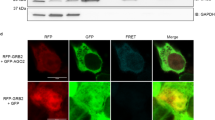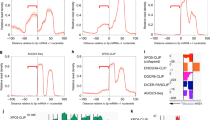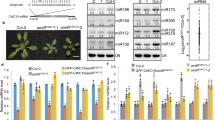Abstract
Consistent with the role of microRNAs (miRNAs) in down-regulating gene expression by reducing the translation and/or stability of target messenger RNAs1, the levels of specific miRNAs are important for correct embryonic development and have been linked to several forms of cancer2,3,4. However, the regulatory mechanisms by which primary miRNAs (pri-miRNAs) are processed first to precursor miRNAs (pre-miRNAs) and then to mature miRNAs by the multiprotein Drosha and Dicer complexes5,6,7,8, respectively, remain largely unknown. The KH-type splicing regulatory protein (KSRP, also known as KHSRP) interacts with single-strand AU-rich-element-containing mRNAs and is a key mediator of mRNA decay9,10. Here we show in mammalian cells that KSRP also serves as a component of both Drosha and Dicer complexes and regulates the biogenesis of a subset of miRNAs. KSRP binds with high affinity to the terminal loop of the target miRNA precursors and promotes their maturation. This mechanism is required for specific changes in target mRNA expression that affect specific biological programs, including proliferation, apoptosis and differentiation. These findings reveal an unexpected mechanism that links KSRP to the machinery regulating maturation of a cohort of miRNAs that, in addition to its role in promoting mRNA decay, independently serves to integrate specific regulatory programs of protein expression.
This is a preview of subscription content, access via your institution
Access options
Subscribe to this journal
Receive 51 print issues and online access
$199.00 per year
only $3.90 per issue
Buy this article
- Purchase on Springer Link
- Instant access to full article PDF
Prices may be subject to local taxes which are calculated during checkout




Similar content being viewed by others
References
Pillai, R. S., Bhattacharyya, S. N. & Filipowicz, W. Repression of protein synthesis by miRNAs: how many mechanisms? Trends Cell Biol. 17, 118–126 (2007)
Kumar, M. S., Lu, J., Mercer, K. L., Golub, T. R. & Jacks, T. Impaired microRNA processing enhances cellular transformation and tumorigenesis. Nature Genet. 39, 673–677 (2007)
Thomson, J. M. et al. Extensive post-transcriptional regulation of microRNAs and its implications for cancer. Genes Dev. 20, 2202–2207 (2006)
Calin, G. A. & Croce, C. M. MicroRNA signatures in human cancers. Nature Rev. Cancer 6, 857–866 (2006)
Kim, V. N., Han, J. & Siomi, M. C. Biogenesis of small RNAs in animals. Nature Rev. Mol. Cell Biol. 10, 126–139 (2009)
Obernosterer, G., Leuschner, P. J., Alenius, M. & Martinez, J. Post-transcriptional regulation of microRNA expression. RNA 12, 1161–1167 (2006)
Guil, S. & Caceres, J. F. The multifunctional RNA-binding protein hnRNP A1 is required for processing of miR-18a. Nature Struct. Mol. Biol. 14, 591–596 (2007)
Viswanathan, S. R., Daley, G. Q. & Gregory, R. I. Selective blockade of microRNA processing by Lin28. Science 320, 97–100 (2008)
Gherzi, R. et al. A KH domain RNA binding protein, KSRP, promotes ARE-directed mRNA turnover by recruiting the degradation machinery. Mol. Cell 14, 571–583 (2004)
Garcia-Mayoral, M. F. et al. The structure of the C-terminal KH domains of KSRP reveals a noncanonical motif important for mRNA degradation. Structure 15, 485–498 (2007)
Haase, A. D. et al. TRBP, a regulator of cellular PKR and HIV-1 virus expression, interacts with Dicer and functions in RNA silencing. EMBO Rep. 6, 961–967 (2005)
Min, H., Turck, C. W., Nikolic, J. M. & Black, D. L. A new regulatory protein, KSRP, mediates exon inclusion through an intronic splicing enhancer. Genes Dev. 11, 1023–1036 (1997)
Kroll, T. T., Zhao, W. M., Jiang, C. & Huber, P. W. A homolog of FBP2/KSRP binds to localized mRNAs in Xenopus oocytes. Development 129, 5609–5619 (2002)
Roush, S. & Slack, F. J. The let-7 family of microRNAs. Trends Cell Biol. 18, 505–516 (2008)
Garcia-Mayoral, M. F., Diaz-Moreno, I., Hollingworth, D. & Ramos, A. The sequence selectivity of KSRP explains its flexibility in the recognition of the RNA targets. Nucleic Acids Res. 36, 5290–5296 (2008)
Ruggiero, T. et al. Identification of a set of KSRP target transcripts upregulated by PI3K-AKT signaling. BMC Mol. Biol. 8, 28 (2007)
Johnson, S. M. et al. RAS is regulated by the let-7 microRNA family. Cell 120, 635–647 (2005)
Sampson, V. B. et al. MicroRNA let-7a down-regulates MYC and reverts MYC-induced growth in Burkitt lymphoma cells. Cancer Res. 67, 9762–9770 (2007)
Lee, Y. S. & Dutta, A. The tumor suppressor microRNA let-7 represses the HMGA2 oncogene. Genes Dev. 21, 1025–1030 (2007)
Cimmino, A. et al. miR-15 and miR-16 induce apoptosis by targeting BCL2. Proc. Natl Acad. Sci. USA 102, 13944–13949 (2005)
Chen, J. F. et al. The role of microRNA-1 and microRNA-133 in skeletal muscle proliferation and differentiation. Nature Genet. 38, 228–233 (2006)
Kim, H. K., Lee, Y. S., Sivaprasad, U., Malhotra, A. & Dutta, A. Muscle-specific microRNA miR-206 promotes muscle differentiation. J. Cell Biol. 174, 677–687 (2006)
Newman, M. A., Thomson, J. M. & Hammond, S. M. Lin-28 interaction with the Let-7 precursor loop mediates regulated microRNA processing. RNA 14, 1539–1549 (2008)
Rybak, A. et al. A feedback loop comprising lin-28 and let-7 controls pre-let-7 maturation during neural stem-cell commitment. Nature Cell Biol. 10, 987–993 (2008)
Piskounova, E. et al. Determinants of microRNA processing inhibition by the developmentally regulated RNA-binding protein Lin28. J. Biol. Chem. 283, 21310–21314 (2008)
Heo, I. et al. Lin28 mediates the terminal uridylation of let-7 precursor microRNA. Mol. Cell 32, 276–284 (2008)
Michlewski, G., Guil, S., Semple, C. A. & Caceres, J. F. Posttranscriptional regulation of miRNAs harboring conserved terminal loops. Mol. Cell 32, 383–393 (2008)
Chen, C. Y. et al. Nucleolin and YB-1 are required for JNK-mediated interleukin-2 mRNA stabilization during T-cell activation. Genes Dev. 14, 1236–1248 (2000)
Schrimpf, S. P., Langen, H., Gomes, A. V. & Wahlestedt, C. A two-dimensional protein map of Caenorhabditis elegans. Electrophoresis 22, 1224–1232 (2001)
Martin, S. R. et al. Interaction of calmodulin with the phosphofructokinase target sequence. FEBS Lett. 577, 284–288 (2004)
Delaglio, F. et al. NMRPipe: a multidimensional spectral processing system based on UNIX pipes. J. Biomol. NMR 6, 277–293 (1995)
Goddard, T. D. & Kneller, D. G. SPARKY, University of California, San Francisco 〈http://www.cgl.ucsf.edu/home/sparky/〉.
Koradi, R., Billeter, M. & Wuthrich, K. MOLMOL: a program for display and analysis of macromolecular structures. J. Mol. Graph. 51-5, 29–32 (1996)
Kerr, M. K. & Churchill, G. A. Experimental design for gene expression microarrays. Biostatistics 2, 183–201 (2001)
Zhang, H., Kolb, F. A., Brondani, V., Billy, E. & Filipowicz, W. Human Dicer preferentially cleaves dsRNAs at their termini without a requirement for ATP. EMBO J. 21, 5875–5885 (2002)
Dorin, D. et al. The TAR RNA-binding protein, TRBP, stimulates the expression of TAR-containing RNAs in vitro and in vivo independently of its ability to inhibit the dsRNA-dependent kinase PKR. J. Biol. Chem. 278, 4440–4448 (2003)
Kotaja, N. et al. The chromatoid body of male germ cells: similarity with processing bodies and presence of Dicer and microRNA pathway components. Proc. Natl Acad. Sci. USA 103, 2647–2652 (2006)
Chen, C. Y. et al. AU binding proteins recruit the exosome to degrade ARE-containing mRNAs. Cell 107, 451–464 (2001)
Briata, P. et al. p38-dependent phosphorylation of the mRNA decay-promoting factor KSRP controls the stability of select myogenic transcripts. Mol. Cell 20, 891–903 (2005)
Wu, Z. et al. p38 and extracellular signal-regulated kinases regulate the myogenic program at multiple steps. Mol. Cell. Biol. 20, 3951–3964 (2000)
Gherzi, R. et al. The RNA-binding protein KSRP promotes decay of beta-catenin mRNA and is inactivated by PI3K-AKT signaling. PLoS Biol. 5, e5 (2006)
Acknowledgements
We thank V. Narry Kim, T. C. Hobman, I. G. Macara, D. Srivastava and J. G. Belasco for reagents, G. Corte for sharing laboratory facilities and critical reading, Y. T. Liu for use of the microarray facility, M. Ponassi and C. Nelson for technical assistance, I. Diaz-Moreno, M. Doyle, S. Martin and D. Hollingworth for discussions and reagents, and A. Pasquinelli and A. De Flora for comments and discussions. Part of the studies has been conducted in the laboratories and facilities of the Centro Biotecnologie Avanzate (CBA, Genova, Italy). M.G.R. is an investigator with the Howard Hughes Medical Institute. M.T. is supported by a post-doctoral fellowship from the Italian Telethon Foundation. This work has been partly supported by grants from Italian ISS (527B/2B/6), AIRC and CIPE 2007 to R.G., ISS (526D/39) to P.B., the EC FP6 Program Sirocco to W.F. and NIH grants DK018477, DK39949 and HL065445 to M.G.R. P.B. is recipient of a Senior Scholar Consultancy grant from AICF. Structural work on KSRP–RNA interaction is supported by grant WT022088MA from the Wellcome Trust. NMR spectra were recorded at the MRC Biomedical NMR Centre, London. The Friedrich Miescher Institute is supported by the Novartis Research Foundation.
Author information
Authors and Affiliations
Corresponding authors
Supplementary information
Supplementary Information
This file contains Supplementary Figures 1-14 with Legends and Supplementary Tables I and II. (PDF 7469 kb)
Rights and permissions
About this article
Cite this article
Trabucchi, M., Briata, P., Garcia-Mayoral, M. et al. The RNA-binding protein KSRP promotes the biogenesis of a subset of microRNAs. Nature 459, 1010–1014 (2009). https://doi.org/10.1038/nature08025
Received:
Accepted:
Published:
Issue Date:
DOI: https://doi.org/10.1038/nature08025
This article is cited by
-
KSRP improves pancreatic beta cell function and survival
Scientific Reports (2024)
-
The RNA-binding protein KSRP aggravates malignant progression of clear cell renal cell carcinoma through transcriptional inhibition and post-transcriptional destabilization of the NEDD4L ubiquitin ligase
Journal of Biomedical Science (2023)
-
Recent advances on high-efficiency of microRNAs in different types of lung cancer: a comprehensive review
Cancer Cell International (2023)
-
Targeting microRNAs as a promising anti-cancer therapeutic strategy against traffic-related air pollution-mediated lung cancer
Cancer and Metastasis Reviews (2023)
-
Visualizing a protonated RNA state that modulates microRNA-21 maturation
Nature Chemical Biology (2021)
Comments
By submitting a comment you agree to abide by our Terms and Community Guidelines. If you find something abusive or that does not comply with our terms or guidelines please flag it as inappropriate.



